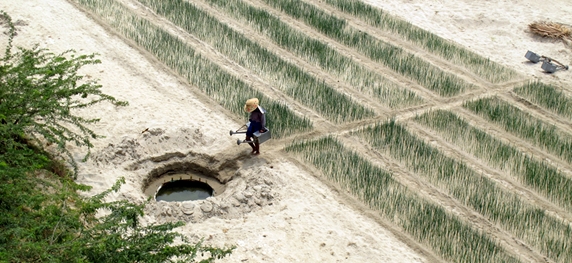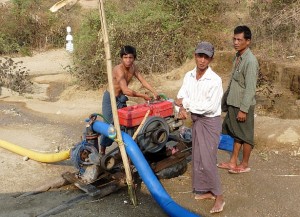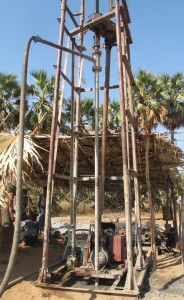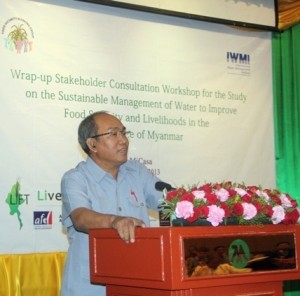Something magical happens when researchers respond directly to development challenges and the needs of end users. There is interest in the findings, it is easy to get feedback and new opportunities emerge almost seamlessly through engagement and partnership.
Myanmar is opening up at an unprecedented rate. Government officials and development agencies are hungry for evidence-based research that can help them make important decisions regarding national strategies or donor investments. Little empirical research on specific development problem sets has been carried out.
The Livelihoods and Food Security Trust Fund (LIFT) is developing a program for the Dry Zone that will be implemented from 2013 to 2016. As water-related concerns are known to have a strong bearing on food insecurity and low incomes in the Dry Zone, LIFT contacted the International Water Management Institute (IWMI) to undertake a rapid review of access to, and management of, water resources.

The IWMI study which was conducted over the last 6 months (January – June, 2013), was broadly divided into three components: (i) assessment of the physical water resources in the Dry Zone area; (ii) a community level survey to evaluate issues of water availability, access and management for local communities in villages in the Dry Zone, as well as an evaluation of institutional arrangements in relation to farming strategies and water management practices; and (iii) a synthesis of key findings and recommendations of priority actions (i.e., targeted interventions) to improve access to, and management of, water resources in the Dry Zone.
IWMI worked in collaboration with several local partners to carry out this study with funding from LIFT. These partners included the National Engineering and Planning Services (NEPS); Myanmar Marketing Research and Development (MMRD) Research Services; the Food Security Working Group (FSWG); the Department of Irrigation, Ministry of Agriculture and Irrigation; and the Water Resources Utilization Department (WRUD).
Disseminating the results
A feedback workshop was held on June 28, 2013, to disseminate the initial results of the findings to stakeholders working in the Dry Zone and to also get their feedback before the study was completed. More than 45 participants from government agencies, civil society organizations and donor agencies attended the workshop.
The recommendations from the overall study were grouped into five key areas:[fancy-ol style=”decimal” variation=”blue”]
- Formal irrigation schemes.
- Groundwater interventions.
- Rainwater harvesting.
- Soil conservation and watershed management.
- Water resources planning and information management.
[/fancy-ol]
Some of the feedback received and discussions held at the workshop centered around the key areas mentioned above.

The study recommended to improve the performance of irrigation systems through several means. First, it highlighted the need to synergize farmer-agency relationships, emphasizing on their complementary roles in system management. Second, irrigation investment should be linked with the government’s agricultural development strategies in relation to rice production policies and crop diversification. Discussants also acknowledged that irrigation by itself is unlikely to make a difference to the incomes and livelihoods of farmers, and complementary investments in input and output markets are required. Finally, some key research areas to better understand the impact of irrigation on incomes and livelihoods were identified.
Drinking water must be made priority
Groundwater resources are still not well understood due to a lack of evidence-based information on quantity and quality.

Photo credit: Sonali S. Sellamuttu
The provision of drinking water must be the highest priority, and plans to expand irrigation development should not compromise current or future access to drinking water supplies (for people and livestock). It was suggested that the IWMI study did not seem to have clearly mapped out the types of interventions that were best suited (from a techno-economic perspective) to different parts of the Dry Zone. This would be a useful area to include in any future follow-up research work.
Watershed management emerged as another important area. The key concept is to slow the passage of water through the landscape, both to increase the availability of water, and to reduce erosion and land degradation. This involves working at a range of scales, from in-field soil conservation approaches (such as mulching and bunds) to banks, dams and reforestation at catchment scales. Land degradation has long been recognized as an issue in the Dry Zone, but the outcomes of watershed management programs initiated in the 1990s and 2000s have not been evaluated. Assessing the successes and failures from past programs, and building from the considerable body of experience, is an important precursor to planning new initiatives. Workshop participants also stressed the importance of finding incentives to involve farmers and communities in watershed management programs, where the benefits are often long-term and dispersed.
Rainwater harvesting and upscaled storage
Closely linked to watershed management is another recommendation for the Dry Zone that focused on decentralized or ex-situ rainwater harvesting (RWH) technologies, which include structures built to capture rainfall such as ponds, tanks, reservoirs and small dams. There were two broad recommendations that were discussed during the workshop: (i) enhancing the use of rainwater harvesting technologies in agricultural irrigation where appropriate, and (ii) up-scaling current rainwater storage infrastructure.
With the first recommendation, the participants agreed that, currently, a large number of RWH infrastructure in the Dry Zone was being used mainly for domestic purposes and that there was potential to increase its use in the context of agriculture. With respect to the second recommendation, participants indicated that in addition to a number of nongovernmental organizations (NGOs) (such as ActionAid, Adventist Development and Relief Agency [ADRA] and Proximity Designs) that are working in the Dry Zone, the government is also involved in supporting RWH infrastructure development.
For example, in 2012, in the Mandalay Region, the regional government requested the support of the Irrigation Department to undertake renovation and reconstruction work in addition to building new storage structures for RWH which were intended for multiple uses (irrigation as well as domestic purposes). A number of potential follow-up research areas in relation to RWH were suggested by the workshop participants, which included: a survey to prioritize which ponds should be reconstructed; assessing the sustainability of water user groups in the Dry Zone; a mapping exercise to determine which areas in the Dry Zone are most suitable for RWH; and an economic analysis of the maintenance and rehabilitation of RWH infrastructure and benefits of their use.
A government owned process
Finally, the development of a comprehensive data management system would make a significant contribution to evidence-based research. Many participants at the workshop agreed and also helped to change the original recommendation which focused on using a non-government agency. Participants agreed that it is essential that the development of such a water data management system is a government “owned” process. This, again, demonstrates the importance of listening to partners. IWMI also has added experience of this in Sri Lanka as well as a partnership in Bangladesh working under the CGIAR Challenge Program on Water and Food (CPWF).
Andrew Kirkwood, Director of LIFT, mentioned that this was a hallmark study not only for what was found but more for what it represents: “This is one of the first times we have been able to bring together stakeholders to discuss around independent research. This really shows the value of bringing in expertise from the outside to help carry out evidence-based research. This type of research is crucial in two ways. First, we hope this helps not only LIFT to make investment decisions but also other agencies and donor organizations. Second, dialogue around evidence-based research helps bring government and civil society together to discuss research findings rather than focus on their own positions.”

Ohnmar Khaing, Coordinator, FSWG, indicated that, “This was a very useful study and the information generated would be very valuable to the FSWG members, especially those working in the Dry Zone.” She further went on to say that, “It would be very useful to translate the key recommendations into the national language and circulate these widely.”
For IWMI, this process has been an important first step in building partnerships in Myanmar, and to demonstrate how the Institute’s research can have a direct impact on development activities.
Sonali Senaratna Sellamuttu, Senior Researcher – Livelihood Systems, IWMI, summed it up: “IWMI and other CGIAR Centers are moving towards an evidence-based approach and this can be done effectively when we are responding to the needs of our partners. This partnership with LIFT, FSWG, Irrigation Department and WRUD has clearly demonstrated what can be done when IWMI brings together its multi-disciplinary expertise to address specific problem sets identified by partners.”
[hr top=”yes”/]
Written by Michael Victor, Engagement, Communications and Knowledge Management Coordinator, CGIAR Research Program on Water, Land and Ecosystems (WLE), and Sonali Senaratna Sellamuttu, Senior Researcher – Livelihood Systems, IWMI; with contributions from Matthew McCartney, Principal Researcher – Hydrologist and Office Head, IWMI Laos Office; Robyn Johnston, Senior Researcher – Water Resources Planner, IWMI; Diana Suhardiman – Researcher – Policy and Institutional Analyst, IWMI; Paul Pavelic, Principal Researcher – Hydrogeology, IWMI; and Soumya Balasubramanya, Researcher – Environmental Economics, IWMI.

